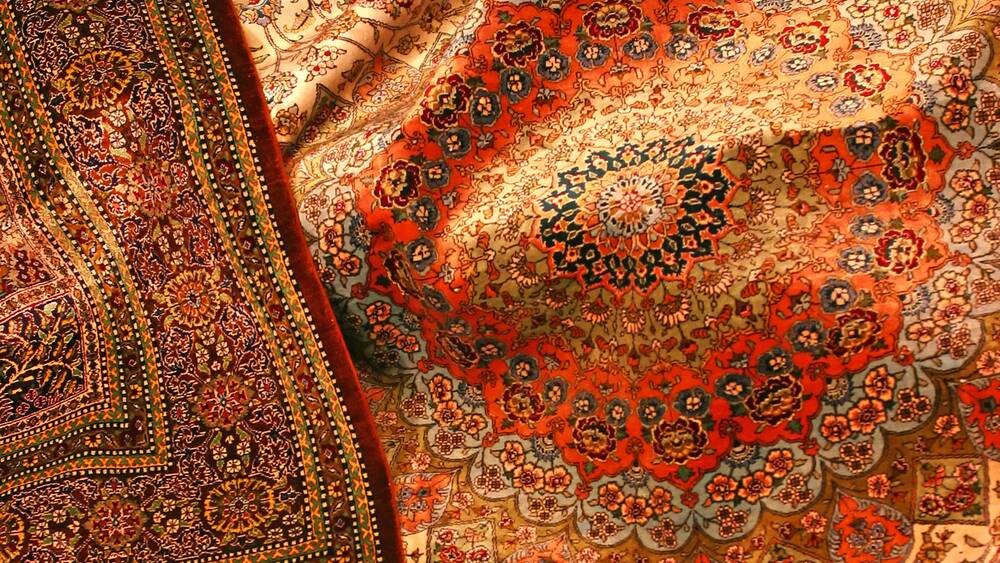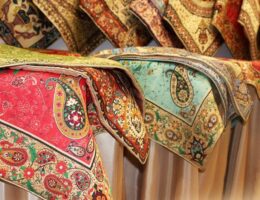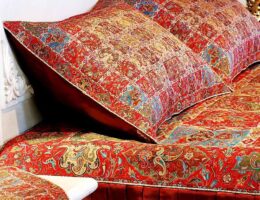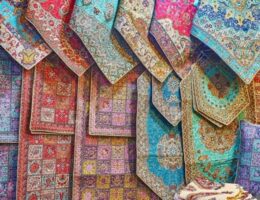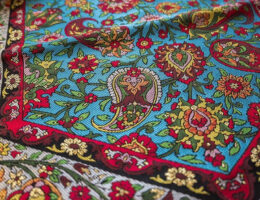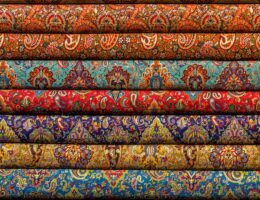IRAN ART EXHIBITION: IN YOUR VISIT TO IRAN, DON’T FORGET TO BUY HANDWOVEN CARPET
Persian carpet is one of the luxurious Iranian handicrafts, well representative of Persian culture, that any visitor needs to bring back home as a souvenir from their trip to Iran. Persian carpet is the most elegant souvenir of Iran and enjoys an international reputation. On this post, I will expand on the Persian carpet and introduce its various types, in addition to the practical guides about purchasing the Persian carpet. I will share with you how you can buy the right carpet from the right place. Stay with me, so that I can convince you why the Persian carpet is a precious souvenir that you can’t miss!
The Oldest Carpet of the World
Before I describe the Persian carpet in detail, I would like to introduce to you the oldest preserved carpet in the world. The story goes that carpets originated somewhere in the Middle East, although exactly where is still up for debate. Some believe that the carpet came originally from a highly civilized culture such as Persia. Pazyryk carpet is the oldest carpet in existence, dating around 5th BC, and is housed at St. Petersburg’s Hermitage Museum. This early carpet is made of wool and has remained almost intact. The rug was unearthed from the grave of a Scythian (ancient nomadic people of Eurasia) nobleman in Kazakhstan in 1949. The carpet was lucky, as it was frozen in ice and thus very well preserved. Although the carpet is about 3000 years old, it features a truly rich design.
The Golden Age of Persian Carpet
The first documented evidence concerning the Persian carpets dates back to the Sassanid dynasty (224-641 AD). However, the Persian carpet reached its heyday in the Safavid Era in the 16th century. Roughly 1500 Persian carpets from this era have survived. The Safavid carpets were chiefly made of silk and delicately decorated with the gold and silver threads. Today, the Safavid carpets are housed at various museums all over the world. Among all, a well-known example of Safavid Persian carpets from Ardabil is on display in London’s Victoria and Albert Museum.
What Makes The Persian Carpet An Unmissable Souvenir?
In your visit to Iran, make sure not to miss out on your unique Persian souvenir. Persian carpet is an enchanting piece of art that chiefly makes for a souvenir to bring back home. The Persian carpet amazingly reflects the Persian culture. It well represents the close ties of the weavers with the nature. Weaving carpets has been a great way for the weavers to express themselves, their emotions, worries, happiness, and sadness.
While shopping for the Persian carpet, you can explore the countless variety on offer. There are plenty of fiber types of carpet as well as carpet styles, patterns and colors to choose from to satisfy any personal taste and fit any decoration purposes. You can pick from various materials including the natural and synthetic fibers. Moreover, the alluring patterns as well as fascinating colors of Persian carpet create a phenomenal work of art. Thus, the Persian carpet enjoys an international reputation.
Types of Persian Carpet
As you enter the Persian carpet market, you will find yourself before a numerous types of carpets with various functions and features. Stay with me to learn what type of carpet you are handling next time you are in a carpet store.
Gabbeh
IRAN ART EXHIBITION: Gabbeh is a kind of Persian rug mainly woven by Qashqai and Bakhtiyari Nomads of Iran. Indeed, Gabbeh is mainly characterized by its simple design and thickness. It features few decorative elements, which are mainly geometrical patterns and animal motifs. Gabbeh carpets can also reach a thickness of approximately 3 cm. If you are looking for a durable floor cover with low price, Gabbeh is the ideal choice. However, if you choose larger a Gabbeh, your luggage might exceed the maximum weight allowance.
Kilim
Persian Kilim or Gilim is a tapestry woven rug functioning as a floor covering. Traditional Kilims were dyed, using natural colors obtained from the plants and minerals. The kilim weavers often use cotton or sometimes wool as the warp string; moreover, wool is used for the weft. The major distinguishing feature of Kilims is that they are normally thin and light. Thus, they are easier to carry compared to Gabbehs. The most famous Persian Kilims are Shahsavan, Sanandaj, Qashqai, Khamseh, Bakhtiyari, Baluch, Harsin, Zarand, Afshar, and Turkmen.
Jajim
Persian Jajim is a handwoven rug, often made of wool. Jajims feature a coarse texture with plain design. Indeed, they are easily identified by their vertical stripe patterns. Jajims have served a multitude of purposes. They have functioned as carpets, blankets, bed covers, bags, shoes, prayer rugs, as well as furniture covers. The convenient size, weight and price of Jajims make them perfect souvenirs, especially for those tourists who are short on budget or have to struggle the weight limit issue.
Tablo Farsh
The Persian carpets function not only as floor coverings, but also as charming wall decorations. Tablo Farsh is in fact a framed carpet, which depicts numerous patterns including motifs of nature, people, flowers, events, places, and so on. This type of carpet is an amazing decorative handicraft, frequently made of silk threads and provided in various sizes. Tablo Farsh is an exquisite and appealing souvenir that will embellish any wall and match any decorative taste.
Practical Guides For Purchasing Persian Carpets
The Persian carpet comes in various alluring patterns and colors as well as fiber types, sizes, prices and density. If you wish to purchase one of those bewitching Persian carpets, you need to decide between the handmade and the machine-made carpets. Needless to say, the Persian carpet actually refers to the handmade carpets! Now that you have learned about types and history of Persian carpet, you might be convinced that the Persian carpet is a perfect souvenir to buy in Iran. If so, stick with me! I will provide you with some practical tips that can be beneficial while shopping for the Persian carpet.
Materials And Use of Persian Carpet
First characteristics that you need to take into account while shopping for Persian carpets are their material and use. Handmade carpets are mainly made of natural fibers such as wool, silk, or a blend of both, whereas the machine-made carpets are made of synthetic fibers including nylon and polyester. To pick the right carpet fiber, consider your purpose and life style. Nylon is perfect for homes with heavy foot traffic, while polyester fiber is a good value for homes with a normal amount of foot traffic. However, by talking about Persian carpet, one mainly refers to a handmade carpet. So, if you are looking for a perfect representative of Persian carpet, you should definitely go for a silk carpet, the finest of all with a shiny finish. If you are short on budget consider a handmade carpet, Gabbeh, Kilim, or Jajim, made of wool or cotton.
Colors of Persian Carpet
IRAN ART EXHIBITION: The second influential factor in picking the perfect Persian carpet include their color. In general, there are two types of color: natural and synthetic. To distinguish between the natural and synthetic dyes, bend the carpet and isolate some threads. If you notice an uneven distribution of the color, you are touching a naturally-dyed carpet.

Patterns of Persian Carpet
The third feature to take into account in purchasing the perfect Persian carpet is the pattern. When it comes to the pattern of Persian carpet, there is a wide range to choose from, including floral, geometric, and natural motifs. You should choose the right pattern based on your personal preference. The appealing motif can vary from person to person, as it is a matter of taste. Indeed Persian carpet patterns vary from plain vertical stripes of Kilim to more delicate motifs of nature, animals, scenes of significant events, well-known figures and miniature paintings woven to the carpets and Tablo Farshes. These motifs also narrate the stories and emotions of their weavers, as well as their bond to the nature.
Moreover, the patterns of Persian carpet are chiefly representative of the region or the nomadic tribe where they come from. For instance, if you are looking for a delicate pattern, Tabriz carpet should be appealing. On the other hand, if you need a modest pattern, carpets woven in the desert areas and cities like Kerman, are the appropriate choices. Interestingly, different carpets were woven for different occasions, too. For instance, a bride from the Qashqai nomadic tribe, wove the Qashqai wedding Carpet for her future husband and gave it to him as a gift.
Knot Density
The fourth factors that you should consider for choosing a carpet is their knot counts. A quality carpet has at least 120 knots per square inch. To tell between the handmade and machine-made carpets, flip the carpet over and look at the knots from underside. In case you face a uniform set of knots with no bumps, then you know you are dealing with a machine-made carpet. On the other hand, a handmade carpet will have a soft backing with a few knots sticking out.
Budget And Weight Limit
Finally, your budget and the weight limit will be the ultimate factors which might extremely narrow down your choice even further. I highly recommend that you buy a handmade Persian carpet, so that you take with you a unique taste of Persia. The extraordinary pure silk, naturally dyed, handmade carpet is the most perfect and, of course, expensive choice. So, my suggestion will be for you to buy the carpets which are smaller in size, so that you can handle the budget challenge as well as the weight limit. The good news is that a little bit of bargaining is in order!
Best Cities To Buy Persian Carpets
You might wonder where you can shop for quality handmade Persian carpets in Iran. Indeed, you can purchase high quality Persian carpets from various cities in Iran and there is no unique answer to the question “where can I buy the best handmade Persian carpet?”. Each city, region and nomad group, though, offers a certain type of the carpet that might satisfy a certain personal taste. These carpets vary in size, pattern, and material.
IRAN ART EXHIBITION: Tabriz, for instance, is an option, where you can purchase fine Persian carpets with delicate and artistic patterns. The city was named the world carpet weaving city by the World Craft’s Council in October 2015. Once in Tabriz, check out Tabriz Bazaar for quality Tabriz carpet. However, for those who are in Iran for a short time and on a classical tour of Iran, Tabriz might not be an option. So, you can choose from these cities: Shiraz, Yazd, Kashan, Isfahan, and Tehran.
